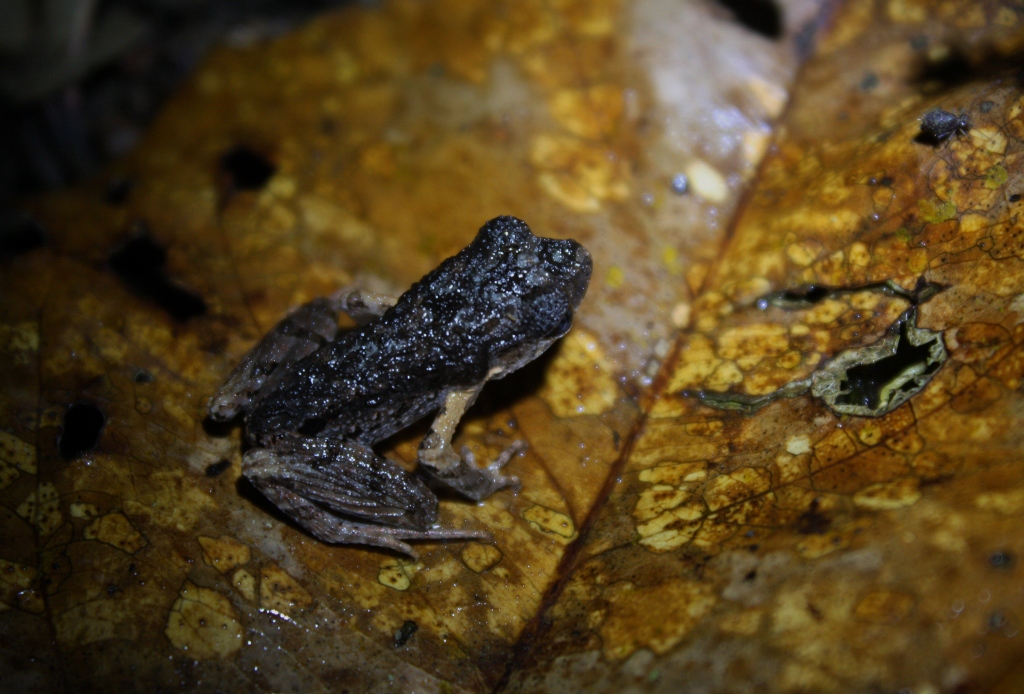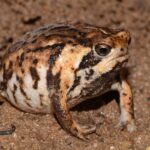- Ansonia latidisca: Rediscovering the Enchanting Bornean Rainbow Toad
- Taxonomy and Classification of Ansonia latidisca
- The Hidden Realms: Natural Habitat of the Rainbow Toad
- Dazzling Patterns and Adaptations: The Physical Characteristics of Ansonia latidisca
- The Life Cycle and Intriguing Behavior of Ansonia latidisca
- A Keystone Amphibian: Ecological Role within its Forest Home
- Conservation Challenges and Rediscovery Efforts
- Cultural and Scientific Significance of Ansonia latidisca
- Conclusion: Protecting the Enigmatic Jewel of Borneo
Ansonia latidisca: Rediscovering the Enchanting Bornean Rainbow Toad#
Hidden deep within the lush montane rainforests of Borneo exists a creature whose vibrancy and elusiveness has captivated scientists, conservationists, and nature enthusiasts alike—the stunningly colored and once presumed-lost Bornean Rainbow Toad, Ansonia latidisca. Discovered over a century ago, only to vanish into complete obscurity shortly thereafter, this unique amphibian became more myth than reality, a ghostly enigma whispered about among herpetologists and local folklore alike. Its dramatic rediscovery in 2011 stands proudly among recent conservation success stories, breathing fresh life into biodiversity narratives and offering renewed hope for other rare species.
But what makes Ansonia latidisca so extraordinary, and why has it inspired such awe and urgency in conservation circles? From ethereal coloration and fascinating behaviors to the fragility of its rainforest home, let’s journey together into the heart of Borneo to encounter the elusive Rainbow Toad.
Taxonomy and Classification of Ansonia latidisca#
Ansonia latidisca, popularly termed the Bornean Rainbow Toad, belongs within the expansive class Amphibia, specifically the family Bufonidae—commonly known as true toads. Within this toad family, the genus Ansonia comprises small-to-medium sized, slender-bodied amphibians generally inhabiting mountain streams and rainforest undergrowth in Southeast Asia.
The Bornean Rainbow Toad was first described scientifically in 1893 by British zoologist George Albert Boulenger. Boulenger’s description, based on a few mysterious specimens from the rugged uplands of northwestern Borneo, would remain the only evidence of the species for more than a hundred years. Its closest biological relatives are similarly secretive toads within the genus Ansonia, such as the equally stunning Ansonia spinulifer.
Together, they represent fascinating evolutionary adaptations to humid montane habitats, offering valuable insights into survival strategies shaped by isolation and specialization.
The Hidden Realms: Natural Habitat of the Rainbow Toad#
To truly appreciate Ansonia latidisca‘s remarkable ecology, one must journey deep into the mountainous rainforests of Borneo, where remote altitudes, misty clouds, and dense foliage intertwine in a timeless dance. Its confirmed habitat rests primarily within the rugged Gunung Penrissen range, straddling the border regions of Sarawak, Malaysia, and Kalimantan, Indonesia, between elevations of 1000 and 1300 meters. This montane rainforest is characterized by lush understory plants, thick moss-covered rocks, and clear, rapidly flowing streams—precisely the dramatic landscapes that fuel biodiversity hotspots.
The Rainbow Toad prefers humid environments with consistent rainfall patterns, thriving beneath the dense canopy that cloaks much of Penrissen’s slopes in perpetual twilight. Thick, saturated moss layers form carpets on damp granite outcrops and along tree roots—a microhabitat critical for its sensitive skin and moisture-dependent biology. Here, hidden among mist trails, concealed among ferns and orchids, lives one of the most captivating yet cryptic amphibians ever discovered.
Its elusive habits and the ruggedness of its habitat largely contributed to the species’ lengthy disappearance from scientific view, fueling decades of speculation about its continued existence until its astonishing rediscovery.
Dazzling Patterns and Adaptations: The Physical Characteristics of Ansonia latidisca#
Upon first sighting, the incredible beauty and remarkable coloration of the Bornean Rainbow Toad immediately stand out among the rainforest greens. Its body length typically reaches between 30 to 50 millimeters—relatively small yet strikingly intricate. More notable still is its spectacular skin coloration, a stunning mosaic of vibrant yellows, vivid greens, delicate blues, purples, and reds patterned beautifully across the back, sides, and limbs. This riot of color isn’t merely decorative; scientists theorize these bold hues may serve as cryptic camouflage within the richly pigmented mosses and foliage, concealing the toad against predators and curious observers alike.
Aside from its gorgeous coloration, Ansonia latidisca also possesses unique physical adaptations ideal for a life spent clinging to moist habitats and vertical surfaces. Its fingertips and toes are equipped with adhesive pads enabling impressive climbing ability, crucial for navigating slippery rock faces and moist vegetation that characterize its mountainous habitat. The skin texture is granular, dotted generously with small bumps or tubercles which, besides enhancing camouflage, may also play a role in maintaining moisture balance in an environment where dehydration represents a perpetual threat.
The Life Cycle and Intriguing Behavior of Ansonia latidisca#
Feeding Habits: Masterful Insect Hunter#
Like many small tropical amphibians, the Rainbow Toad primarily consumes insects and small arthropods abundant in its surroundings. Crickets, ants, spiders—each meal caught through stealth, patience, and dexterity. Unlike larger predatory amphibians, these vibrant toads rely on ambush hunting or opportunistic feeding along mossy trails rather than active chase. Equipped with acute vision, they remain stealthier, utilizing their coloration to blend seamlessly until prey unknowingly wanders into photographic action. Their efficient feeding strategy sustains their energy demands while reducing exposure to predators.
Reproduction and Breeding Behaviors#
The reproduction strategy of Ansonia latidisca parallels other stream-breeding amphibians within its genus, involving distinctive and secretive mating rituals close to running water. During breeding periods, males attract prospective mates through soft, melodious breeding calls emitted from strategic positions along streams, branches, or rocks. Egg-laying occurs in well-hidden areas close to water, ensuring the developing tadpoles’ timely transition to aquatic environments. Larvae (tadpoles) possess specialized adaptations facilitating life in dynamic, swiftly flowing rainforest streams, including muscular tails and mouths adapted for scraping algae.
A Keystone Amphibian: Ecological Role within its Forest Home#
In the intricate web of rainforest ecology, the Rainbow Toad functions as both predator and prey, acting as a vital control force on insect populations and providing nourishment for snakes, birds, and predatory mammals. Its healthy presence can also indicate pristine habitat conditions; sensitive skin makes amphibians excellent bioindicators, responding rapidly to ecological stressors such as pollutants, habitat change, or climate shifts. Consequently, the thriving existence of amphibians like the Rainbow Toad directly highlights rainforest vitality and biodiversity stability.
Conservation Challenges and Rediscovery Efforts#
Until 2011, Ansonia latidisca lay hidden in scientific obscurity, classified as extinct or possibly extirpated from its historic range. Surprising the world, enthusiastic conservationists and scientists embarked on determined expeditions spearheaded by Conservation International, ultimately rediscovering several living individuals in Sarawak’s Gunung Penrissen range. This immensely successful expedition reignited optimism for Borneo’s amphibian diversity but also highlighted ongoing vulnerabilities.
The species currently holds an “Endangered” status on the IUCN Red List, with significant threats looming, particularly habitat loss from logging, agricultural encroachment, and broad-scale deforestation. Unchecked urban development, pollution, disease susceptibility like chytrid fungus outbreaks, and climate alterations pose ongoing threats requiring immediate attention and protective actions.
Cultural and Scientific Significance of Ansonia latidisca#
Beyond its ecological niche, the Bornean Rainbow Toad symbolizes biodiversity resilience and is recognized among locals and enthusiasts as an emblem of hidden wonder in nature’s biodiversity. Scientifically, understanding this species grants insight into adaptive evolution in isolated mountainous landscapes, inspiring further research and conservation initiatives concerning other threatened amphibians. Culturally, such vibrant amphibians capture imaginations, conveying the vital message that preserving even the smallest, rarest creatures holds immeasurable aesthetic and practical value.
Conclusion: Protecting the Enigmatic Jewel of Borneo#
Ansonia latidisca, the exquisite and elusive Rainbow Toad, exemplifies nature’s ability to surprise, enchant, and teach valuable lessons regarding biodiversity preservation and environmental stewardship. However, without concerted conservation efforts supporting habitat protection, ecosystem management, and public awareness campaigns, this stunning amphibian’s existence may once again fade into obscurity.
We, as stewards of Earth’s precious wildlife, must cherish such irreplaceable species—and above all, let the inspiring story of the Bornean Rainbow Toad galvanize us into action, toward safeguarding not only these magnificent toads but their broader rainforest habitat for future generations.












